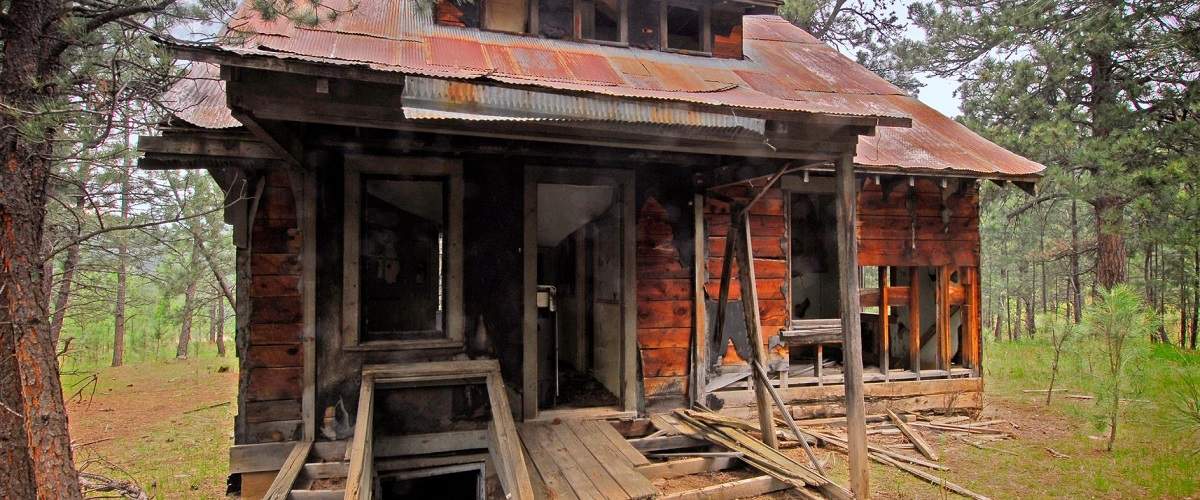
Fans of all things eerie and history buffs alike are sure to appreciate a tour through the remarkable ghost towns in South Dakota. The sight of a formerly bustling community that now has abandoned, crumbling buildings and tumbleweeds rolling through the quiet town square is enough to make the hair on the back of anyone’s neck stand up. There is also no better way to learn about the history of the Mount Rushmore State than to witness, up close and personal, the artifacts that help chronicle life in the area throughout the years.
And the best part is that you don’t have to spend all day in your car in order to witness these mysterious ghost towns; many are within a short drive from the Powder House Lodge. Pack your camera and sense of adventure and plan a tour through these South Dakota ghost towns during your next visit to the Black Hills.
Rockerville
Initially a mining camp founded in 1876, Rockerville has a similar story to that of many Black Hills towns that popped up during the gold rush – their heyday was short-lived because after the treasure was found, people moved on in search of new prospects.
But unlike most of the other post-gold rush ghost towns in South Dakota, the community was revived as a tourist destination in the 1950’s because of its location off Highway 16 between Rapid City and Mount Rushmore. Gift shops, melodrama live theaters, motels and even a museum lined the small town’s streets and drew in the plentiful traffic that was on their way to see the popular monument. That increase in traffic soon saw Highway 16 expanding, and because widening the already existing road through the town was impractical, the highway was instead rerouted around Rockerville.
After the highway no longer led people directly through Rockerville, tourists stopped visiting the tucked-away town. The decreased traffic soon resulted in the town becoming deserted, and almost completely uninhabited, by the 1990’s. In 2016, some of the run-down buildings that were still standing throughout the town were burned down in a fire training exercise held by the Rockerville Volunteer Fire Department.
The lone survivor of Rockerville’s lively days is a restaurant, The Gaslight Restaurant and Saloon, which is still open for business. There are also rural residential areas that were built close to Rockerville, but for the most part, it still maintains its reputation as a Black Hills ghost town.
Mystic
What better name for a ghost town than Mystic, a word that conjures up thoughts of the paranormal and otherworldly? Located off of a gravel road 12 miles north of Hill City, Mystic saw many entrepreneurs trying to strike it big before its eventual demise.
The small town, which was established in 1876, was originally known as Sitting Bull. In 1889, a new railroad, the Chicago, Burlington & Quincy Railroad, was built in Mystic, and was the first line in the Black Hills. Coal and lumber from the Black Hills and Wyoming were transported on the trains, and helped spark the economy in the area. In 1906, a railroad line from Mystic to Rapid City was made, called the Crouch Line. With increased traffic through the area, more people arrived in search of achieving the American Dream.
In 1900, Chicago investors put $1 million into the Mystic Reduction Mill, an operation that utilized electrolysis to extract precious metal from ore; however, the ore wouldn’t suspend in the solution as it was supposed to and instead settled in tanks and solidified. Eventually, the mill was torn down in 1913. A sawmill was later built on the site, but was destroyed by a fire in 1936.
Miraculously, Mystic survived the Great Depression, but flooding and lack of timber afterwards closed the Crouch Line, and, in time, the Chicago, Burlington and Quincy train also stopped going through the small town and the tracks were demolished, with the town soon being abandoned.
Mystic was added to the National Register of Historic Places in 1986. Today, you can walk along the old railroad route by accessing the Mystic Trailhead on the Mickelson Trail. The hike is popular among locals and visitors alike for an exhilarating trek with fantastic views.
Etta
Located only a short five minute drive from the Powder House Lodge, nestled right outside of Keystone, Etta is a Black Hills ghost town that also has a mining history. Originally used to mine tin ore in the 1880’s, the Etta Mine was eventually turned into a mill that was used to smelt cassiterite and over the years evolved into a mine that produced spodumene, a lithium ore. The quarry ended up becoming well-known for its massive crystals, and was even the site where the largest spodumene crystal in the world was found. The mine finally closed down in 1959, resulting in the town becoming deserted as well.
Today, visitors to the mine can observe the remainder of the lithium mine, as well as what’s left of the cassiterite mill and the other buildings that are still standing.
Spokane
Located a short 17 minute drive from the Powder House, Spokane is a Black Hills ghost town that is another remnant of the gold rush days. While people were initially enticed by the area’s promise of gold, it was soon discovered that silver, lead, copper, zinc and other minerals could also be extracted from the Spokane Mine. Although the early days in Spokane were profitable, the mine began to fail and by 1940 the mine, as well as the whole town, was abandoned.
One of the structures that are the most intact in the ghost town today is the old mine manager’s house, which is thought to have been occupied until the 1970’s. Tales about Spokane claim that the Marshall Tucker Band’s song “Fire on the Mountain” was inspired by a grave on the hill next to the manager’s home. The song tells the story of a man seeking treasure during the gold rush, so he packs up and heads west with his family, only to be “shot down in cold blood by a gun that carried fame, all for a useless and no good worthless claim.” The miner who is buried on top of the hill in Spokane met a similar fate, with his story displayed on his grave.
Ardmore
Only considered a ghost town since 2004, Ardmore is a recent addition to the desolate communities that are scattered throughout the Mount Rushmore state. Founded in 1889, the agricultural town, located one mile north of the South Dakota/Nebraska border, hung on strong through the Great Depression without one family needing to depend on welfare.
In the following years, however, the population rapidly declined as the agriculture industry changed and people moved on in search of better opportunities. Since then, Ardmore has served as one of South Dakota’s ghost towns, with the last recorded population being a mere 16 in 1980. Surprisingly, a reunion is held at Ardmore’s old fire station every couple of years so that previous residents can meet up and reminisce about the good ole days.
If you decide to put Ardmore on your list of places to visit during your ghost town tour, keep an eye out for a white barn that is located high up on a hill while entering Ardmore; the site is a relic from when the government used the land to experiment with dry land farming.
Okaton
Although Okaton still records a population of 36 residents, most of whom live on farms outside of town, the formerly thriving railroad town is a prime destination if you’re looking for a desolate, quiet place where you can still see the remnants of the past.
Located just off I-90, about two hours east of the Powder House, Okaton was founded in 1906 as a place for the workers from the nearby railroad to live; but by the 1980’s, the railroad was no longer in use. The lack of employment options, coupled with the long, harsh winters, caused many people to pack up and head to more promising destinations.
After much of the population had moved on, one family, the Westlakes, decided to use Okaton’s new reputation as a ghost town to draw in tourists. Billboards were put up by the interstate to entice people to the site, and a petting zoo, rock shop, and general store were built to add to the fun. Eventually the Westlakes also left the increasingly deserted town, leaving behind the relics of their roadside attraction.
Aspiring photographers, or anyone looking for an interesting location for a selfie, will find that the slowly collapsing, empty buildings and surrounding plains provide a striking, rustic backdrop for a photo shoot.
A tour through the history-rich ghost towns in South Dakota is sure to be a hit with the entire family and is only one of the many things to do in the Black Hills. Make sure to add this fascinating, educational experience to your itinerary during your next Black Hills vacation.
